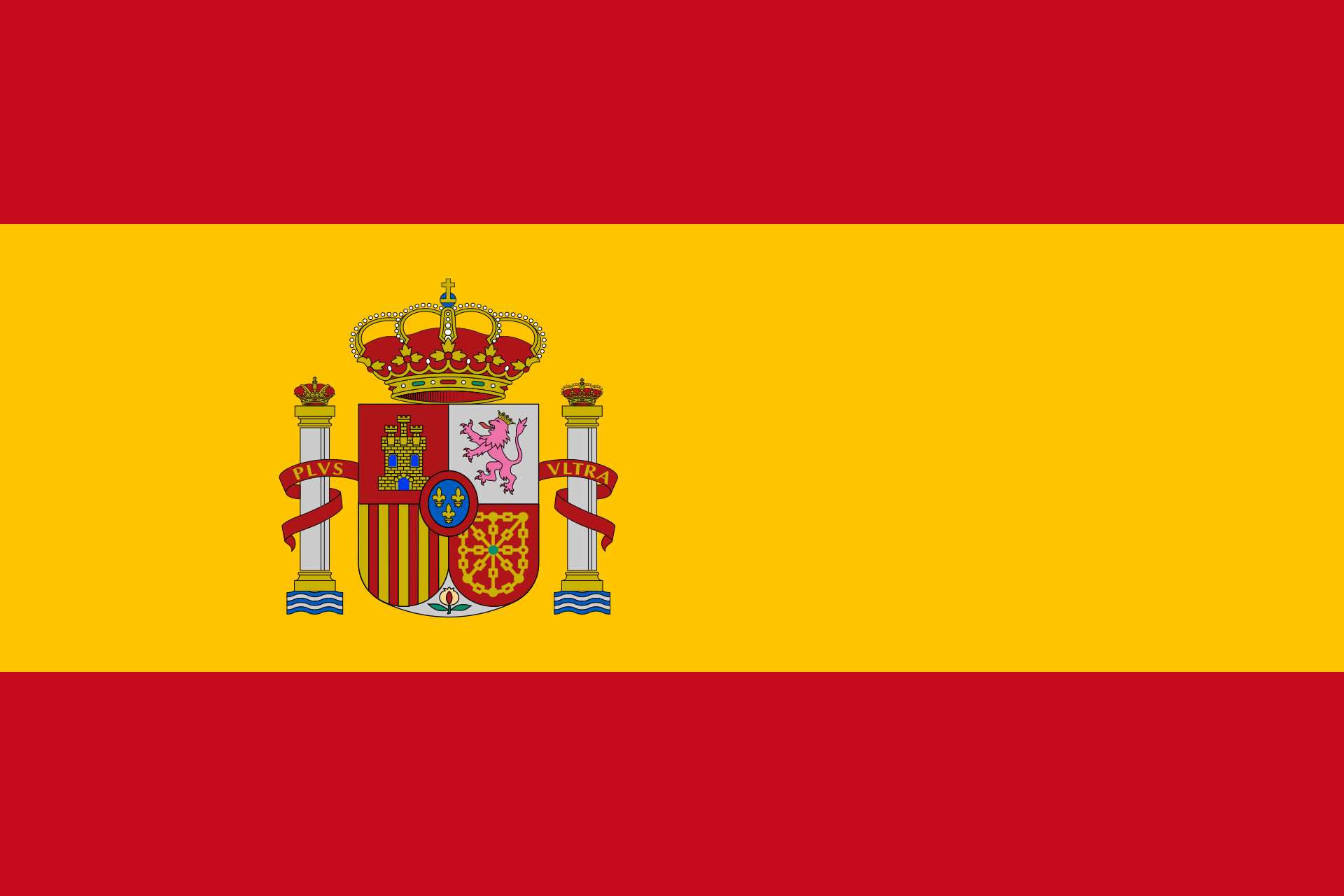National Symbols: Flag Details
Date First Used
October 5, 1981
Nickname(s)
None
Design Elements
A horizontal red-yellow-red triband with the Spanish coat of arms offset by one-third of the flag's length toward the hoist on the yellow band. The yellow band is twice as wide as the red bands. The height of the coat of arms is two-fifths the flag's width.
Symbols: The coat of arms comprises six different coats of arms held within a shield. A golden castle against a red background represents Castile. A pink lion against a white background is the coat of arms of León. Vertical red and yellow stripes represent Aragon. Golden chains stand for Navarre. The pomegranate flower symbolizes Granada. The fleur-de-lis represents the House of Bourbon. The Pillars of Hercules stand for the two promontories, Gibraltar and Ceuta, on either side of the Strait of Gibraltar. The royal seal on the coat of arms is attached on both sides to the Pillars of Hercules by red ribbons. The Latin phrase PLUS ULTRA (“further beyond”) is inscribed on the ribbons and refers to the Americas and other former Spanish territories.
Colors: Red and yellow. The two colors are traditional, but have no official interpretation.
Proportions: 2:3.
Variations:
Spain has a civil flag and ensign named La Rojigualda (“The Red-Yellow”), which was adopted in 1978. It has the same design as the national flag without the coat of arms. For the armed forces, the coat of arms is centered on the yellow band. The royal standard is a dark-blue square flag with the king's coat of arms at the center. The civil authority flag is a square version of the national flag.
History
The medieval kingdoms of Spain had their own symbols, and their ships used to display regional flags and standards on both the Mediterranean Sea and the Atlantic Ocean. From the sixteenth century, when the kingdoms merged, until 1758, when the red-yellow-red flag was introduced, Spain flew several different flags. The flag of the Crown of Aragon was yellow and had four horizontal red stripes. The Crown of Castile, which merged with Leon in 1230, used a quartered flag alternating the Castilian and Leonese emblems.
A flag with the red cross of Burgundy against different backgrounds may be the most distinctive flag in Spain's history. This flag, called “Cruz de San Andrés,” was used as a land and military flag until 1843. It first appeared on the Archers of Burgundy's uniforms and later was used on all army uniforms. It was also a regimental flag, and is still sometimes used today.
The Second Spanish Republic, established in 1931, had a tricolor flag with three equal horizontal bands of red, yellow, and indigo. A shield divided into quarters was centered on the yellow band and included the emblems of Castile, Aragon, Leon, and Navarre. In 1939, immediately after the Spanish Civil War, Spain introduced the red-yellow-red flag with the eagle of John the Baptist and the Pillars of Hercules. The eagle was slightly modified in 1945 and again in 1977. From 1938 until 1981, the country used three different national flags with a similar coat of arms.
A new coat of arms was introduced in 1981 to demonstrate the resurgence of Spanish democracy under King Juan Carlos following the end of General Francisco Franco's dictatorial regime. The new shield retains the six coats of arms of the old Spanish kingdoms and the Pillars of Hercules, but adds a crown in honor of the monarchy.
Proper Uses
All Spanish government offices in Spain and abroad should fly the national flag from sunrise to sunset. The flag flies at public offices, businesses, private homes, on ships, in towns, and during official ceremonies. It must be hoisted in the morning and lowered before dark. The flag is used as a symbol of mourning by tying a black ribbon to it or raising it only two-thirds of the way up the flagpole.
Legends, Controversies, and Trivia
The Ikurriña or Ikurrina flag is the official flag of the Basque Country Autonomous Community of Spain. Designed by the founders of the Basque Nationalist Party EAJ-PNV, Luis and Sabino Arana, it is commonly regarded as the national but unofficial symbol of Euskal Herria, or the wider Basque regions. In 1936, it was adopted as the flag of the Basque Autonomous Region. Franco prohibited it in 1938 (although it continued to be used in the Basque departements of France). It became a symbol of defiance – the first actions of the clandestine group ETA, an armed Basque nationalist and separatist organization, involved placing flags in public places. It was legalized in 1977, following the Spanish transition to democracy.
Copyright © 1993—2024 World Trade Press. All rights reserved.

 Spain
Spain 